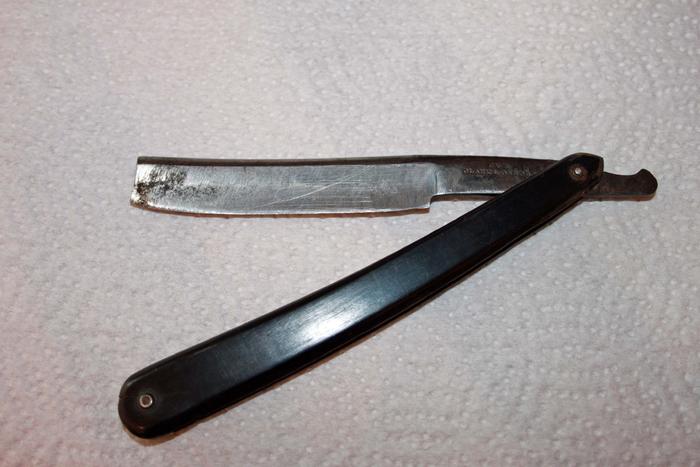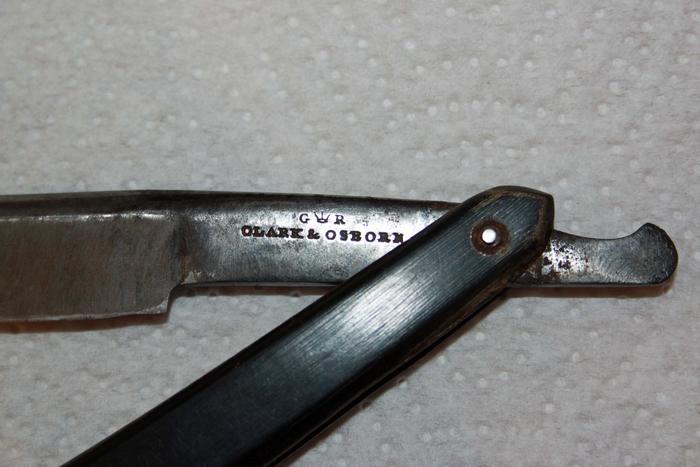Results 1 to 5 of 5
-
12-09-2011, 12:20 PM #1Member

- Join Date
- Oct 2011
- Location
- Arbroath, Scotland
- Posts
- 73
Thanked: 15 Help dating - Clark & Osborn, early 1800's?
Help dating - Clark & Osborn, early 1800's?
I've just aquired this razor - it's marked Clark & Osborn with a GR and crown on the tang. Haven't been able to find anything out about the maker and since we had three Georges on the trot I'm not sure which one it refers to.

George II ruled up to 1760 which seems far too early so I think can be discounted. However his successors reigned 1760-1820 and 1820-1830 so I reckon either of these Georges could fit the bill.

The grind is only just hollow - it's looks like a wedge, the hollowness is only detectable by checking with a straight edge. The scales are black buffalo horn (unfortunately one is cracked) they are very slightly curved. The pivot pin appears to be brass with very small iron collars (the front has mostly rusted away). The spacer is lead (not tapered) and, I'm not sure about the pinning there (relatively) large diameter brass and something else.
The wear appears to be very light, I gave it a handful of passes over a 1k grit to see how it faired and I don't think this razor has seen much action at all.
Shouldn't take too much to get this shaving again, at the moment I'm thinking a light rub down with metal polish then onto the hones. Not sure yet about the scales & pins, would rather not disturb them but unlikely the cracked scale could be repaired without dismantling.
-
12-09-2011, 01:05 PM #2

From the beginning of a distinct tang and the slight curve to the scales that would indicate somewhere around 1810 or shortly thereafter. This info according to "Collecting Straight Razors" by Robert Doyle. There is a sub forum in 'razors' called 'razor clubs' and within that sub forum you'll find 'The Stub Tailed Shavers.' That razor fits into that category. Nice find.
Be careful how you treat people on your way up, you may meet them again on your way back down.
-
12-09-2011, 01:36 PM #3

I think I am right in saying that G crown R refers to the Price Regent George IV who ascended the throne on the 19th July 1821.
Last edited by osdset; 12-09-2011 at 01:39 PM.
-
12-09-2011, 03:07 PM #4Member

- Join Date
- Oct 2011
- Location
- Arbroath, Scotland
- Posts
- 73
Thanked: 15
I'd assumed GR stood for George Rex so could be any of the Georges
 If it refers to the regency that would put it 1811 to 1820 (he actually ascended the throne in 1820 but the coronation didn't take place until 1821.
If it refers to the regency that would put it 1811 to 1820 (he actually ascended the throne in 1820 but the coronation didn't take place until 1821.
My own instinct is that it's post 1800 but no later than 1820.
-
12-10-2011, 12:54 AM #5Senior Member



- Join Date
- Apr 2008
- Location
- Essex, UK
- Posts
- 3,816
Thanked: 3164
They have a long history - first as Clark, Hall & Clark in 1817 then as Clark and Osborn. Clark & Osborn first appeared in trade directories in 1822. The partners were Samuel Osborn and Marmaduke Clark. The company lasted for barely a decade, and Marmaduke died in 1832.
As an aside, one of the sons - Samuel Osborn - became a famous tool steel manufacturer, who also made razors. He bought the rights to the Mushet process and produced fine razors from this steel. Robert Mushet was an ironmaster, working in the Forest of Dean at this time. In 1856 he had perfected Bessemers process for him - although he received little thanks and virtually no recognition for which would otherwise have been a failed process. After this he invented a self-hardening steel by adding tungsten to it - it became known as Robert Mushets Special Steel, and Osborn's razors were marked as such. They are amongst the finest razors I have ever seen. However, by the time Samuel Osborn was using this steel it was 1871 - a long way removed from Clark & Osborn, but interesting (to me, at least!) nevertheless.
Regards,
Neil
-


 2Likes
2Likes
 LinkBack URL
LinkBack URL About LinkBacks
About LinkBacks






 Reply With Quote
Reply With Quote
